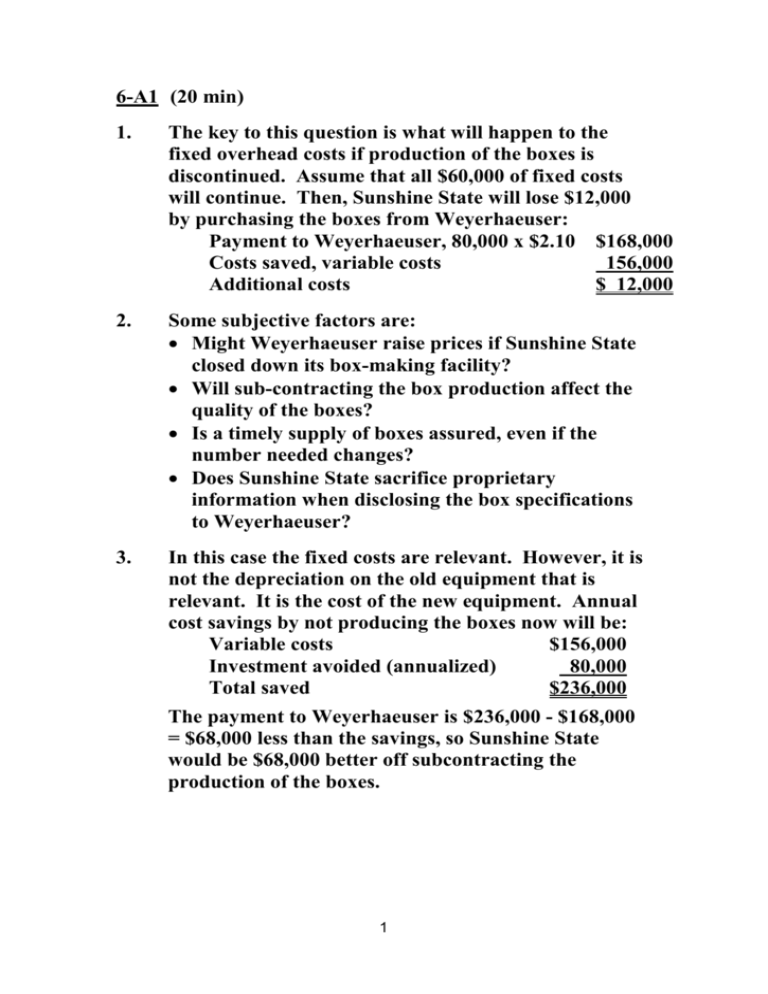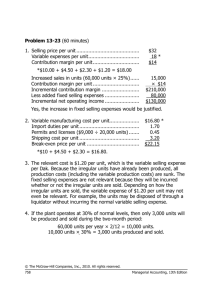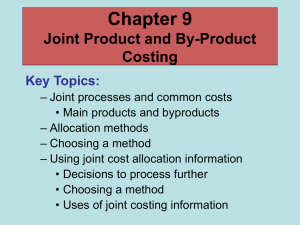answers for ch6 part 2
advertisement

6-A1 (20 min) 1. The key to this question is what will happen to the fixed overhead costs if production of the boxes is discontinued. Assume that all $60,000 of fixed costs will continue. Then, Sunshine State will lose $12,000 by purchasing the boxes from Weyerhaeuser: Payment to Weyerhaeuser, 80,000 x $2.10 $168,000 Costs saved, variable costs 156,000 Additional costs $ 12,000 2. Some subjective factors are: Might Weyerhaeuser raise prices if Sunshine State closed down its box-making facility? Will sub-contracting the box production affect the quality of the boxes? Is a timely supply of boxes assured, even if the number needed changes? Does Sunshine State sacrifice proprietary information when disclosing the box specifications to Weyerhaeuser? 3. In this case the fixed costs are relevant. However, it is not the depreciation on the old equipment that is relevant. It is the cost of the new equipment. Annual cost savings by not producing the boxes now will be: Variable costs $156,000 Investment avoided (annualized) 80,000 Total saved $236,000 The payment to Weyerhaeuser is $236,000 - $168,000 = $68,000 less than the savings, so Sunshine State would be $68,000 better off subcontracting the production of the boxes. 1 6-A2 (10 min.) 1. Contribution margins: Plain = $70 - $50 = $20 Professional = $100 - $70 = $30 Contribution margin ratios: Plain = $20 ÷ $70 = 28.6% Professional = $30 ÷ $100 = 30% 2. Plain Professional a. Units per hour 2 b. Contribution margin per unit $20 Contribution margin per hour $40 Total contribution for 20,000 hours $800,000 3. 1 $30 $30 $600,000 The plain circular saws are the best use of the scarce machine hours. For a given capacity, the criterion for maximizing profits is to obtain the greatest possible contribution to profit for each unit of the limiting or scarce factor. Moreover, fixed costs are irrelevant unless their total is affected by the choice of products. 2 6-A3 (15 min.) Table is in thousands of dollars. 1,2. (a) (b) Sales Beyond Split-Off Sales at Split-Off (a)-(b) (c) (a)-(b)-(c) Separable Costs Incremental Incremental Beyond Gain or Sales Split-Off (Loss) A 230 54 176 190 B 330 32 298 300 C 175 54 121 100 Increase in overall operating income from further processing of A, B, and C (14) (2) 21 5 The incremental analysis indicates that Product C should be processed further, but Products A and B should be sold at split-off. The overall operating income would be $44,000, as follows: Sales: $54,000 + $32,000 + $175,000 Joint cost of goods sold Separable cost of goods sold Operating income $261,000 $117,000 100,000 217,000 $ 44,000 Compare this with the present operating income of $28,000. That is, $230,000 + $330,000 + $175,000 - ($190,000 + $300,000 + $100,000 + $117,000) = $28,000. The extra $16,000 of operating income comes from eliminating the $16,000 loss resulting from processing Products A and B beyond the split-off point. 3 6-32 (15 min.) 1. It is easiest to analyze total costs, not unit costs. Make $300,000 Direct materials Avoidable overhead costs: Indirect labor 30,000 Supplies 20,000 Allocated occupancy cost 0 Purchase cost Total relevant costs $350,000 Purchase $330,000 $330,000 The difference in favor of purchasing is $350,000 $330,000 = $20,000. 2. Because the quantitative difference is small, qualitative factors may dominate the decision. Companies using a just-in-time system need assurance of both quality and timeliness of supplies of materials, parts, and components. A small, local company may not be reliable enough for Bose. In essence, Bose may be willing to "invest" $20,000, the quantitative advantage of purchasing, in order to have more control over the supply of the components. The division manager may have made the right decision for the wrong reason. He incorrectly ignored avoidable fixed costs, leading to a mistaken belief that making the components was less costly by $.30 per unit or $30,000 in total. The $50,000 of avoidable fixed costs makes the purchase option less costly by $20,000. If the manager's decision is to make the component, it should be because forgoing profits of $20,000 has a long-run qualitative benefit of more than $20,000, not because the bid is greater than the variable cost. 4 6-40 (15-20 min.) 1. The difference in total costs over the five years is $3,000 in favor of replacement, computed as follows: Cash operating costs Old machine (book value): Depreciation or Lump-sum write-off Disposal value New machine: Acquisition cost Total costs 2. Five Years Together Keep Replace Difference $22,500 $10,000 $ 12,500 5,000 --- ---$27,500 5,000 -3,000 12,500 $24,500 3,000 -12,500 $ 3,000 The loss on disposal of the old machine combines the lump-sum write-off (an irrelevant item) with the disposal value (a relevant item), $5,000 - $3,000 = $2,000 loss on disposal. Because of the inclusion of an irrelevant item, this amount does not affect the computation in requirement 1. It is best to keep the lump-sum write-off and the disposal value separate, as is done in the table in requirement 1. 5 6-48 (35-50 min.) Note: Requirement 2 of this problem usually gives trouble to students; because Requirement 2 takes considerable class time for a clear explanation, you may prefer to assign Requirement 1 only. 1. There are several ways to approach this problem. The easiest is probably to concentrate on the difference in the total contribution margin. The total fixed costs of $780,000, before considering the increase in advertising, will be unaffected and may be ignored. Production and sales will decline by 10%, from 60,000 to 54,000 units: 60,000 Units $5,400,000 4,200,000 $1,200,000 Sales at $90 and $98, respectively Variable costs at $70* Contribution margin 54,000 Units Difference $5,292,000 3,780,000 $1,512,000 $312,000 *$35 + $12 + $8 + $15 Advertising may be increased by $312,000 without affecting the current operating income level of $420,000 (contribution margin of $1,200,000 minus fixed expenses of $780,000). 2. If the total fixed costs do not change, the company will need a total contribution margin of $1,200,000 from the two products together. How many units of the new product can be sold? The clue to the production capacity of the plant is in how fixed factory overhead was unitized: $300,000 ÷ $6 per unit = 50,000 units of expected sales. 6 New product budget @ 50,000 Units: Sales at $40 Variable costs at $30* Contribution margin, new product *Direct material Direct labor Variable factory overhead Variable selling expense, 10% x $40 Total variable costs per unit $2,000,000 1,500,000 $ 500,000 $ 6 12 8 4 $30 Therefore, the needed contribution margin on the old product is $1,200,000 - $500,000, or $700,000. Sales, 60,000 units at $90 Contribution margin needed Total variable costs that can be sustained Variable selling costs at $9* Maximum that may be paid to the supplier $5,400,000 700,000 $4,700,000 540,000 $4,160,000 *$15 less 40% = $9 or 60% ($15 x 60,000) = $540,000 Maximum unit purchase price, $4,160,000 ÷ 60,000 = $69.33. 7 6-56 (15-30 min.) 1. Sales: 10,000 x 12 x $12 $1,440,000 Less expenses: Direct materials $ 4.20 Direct labor .60 Overhead 1.50 Selling 4.30 10,000 x 12 x $10.60 1,272,000 Operating income [(10,000 x 12) x ($12 - $10.60)] $ 168,000 2. Sales, 10,000 x 12 x 120% x $11 = 144,000 x $11 Less variable expenses, ($4.20 + $.60 + $.70 + $3.20)(144,000) Contribution margin Less fixed expenses, ($.80 + $1.10) x (120,000) Operating income $1,584,000 1,252,800 $ 331,200 228,000 $ 103,200 (A common student error is to use 144,000 units at old fixed costs per unit.) 3. Cost to obtain order: $6,000 ÷ 5,000 Direct materials Direct labor Variable overhead Variable selling expenses: 60% of $3.20 Minimum price for special order $1.20 4.20 .60 .70 1.92 $8.62 4. The variable selling expenses only $3.20 8










